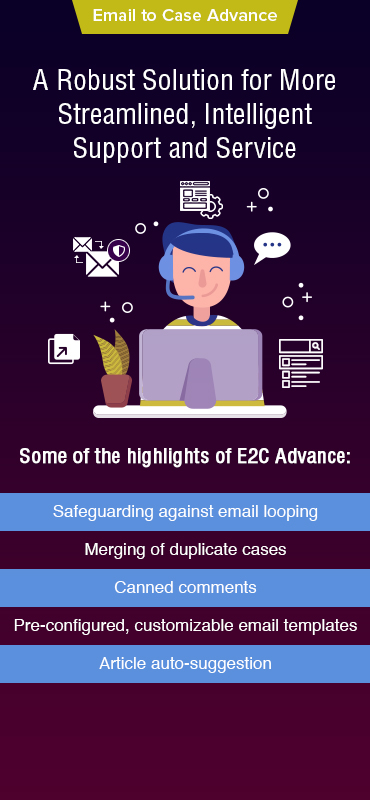Most successful businesses have one thing in common—happy customers!
Achieving customer satisfaction and delivering the best user experience is the ultimate key to being the best in business.
However, providing robust customer services requires stellar, cutting-edge solutions that efficiently manage customer interactions and queries.
Salesforce, the CRM giant, offers Email-to-Case (E2C) to help businesses convert customer emails into actionable cases and enhance overall service delivery.
In this blog post, we’ll discuss how E2C in Salesforce Service Cloud helps you manage customer inquiries effectively. You will also learn how an innovative solution like Email-to-Case Advance (E2CA) accelerates case management with quicker case resolution.
Let’s get started!
How Has Salesforce Case Management Revolutionized Customer Support Solutions?
Email communication is a cornerstone for businesses resolving customer queries. However, managing multiple email threads simultaneously can lead to inefficiencies, delays, and potential oversights.
Salesforce Email-to-Case (E2C) transforms this process by automatically converting incoming customer emails into support cases. For instance, when Mark, a technology enthusiast, encounters issues setting up his newly purchased smartphone, he submits a support request through the website’s contact form. This action triggers the creation of a case in Salesforce.
The system intelligently assigns the case to the appropriate support team based on product category and issue severity. In Mark’s case, the system directs the ticket to Emily, an agent specializing in smartphone support. With access to the entire email conversation within Salesforce, Emily can efficiently address Mark’s concerns. She can leverage Salesforce Knowledge Base articles to find solutions, update case status, and communicate with Mark directly through the platform.
By automating case creation, routing, and management, Salesforce Case Management significantly improves response times, escalates critical issues promptly, and enhances overall customer satisfaction. Additionally, the centralized case repository empowers support teams to access valuable customer data and insights, leading to improved problem-solving and knowledge management.
Does Email-to-Case Lead to Spam Emails and Duplicate Cases?
Although Email-to-Case helps you streamline customer service interactions and improve your overall business productivity, it also poses the risk of creating duplicate cases.
Multiple cases with the same subject line can clog your inbox causing confusion and frustration. This can negatively impact your customer service performance and increase support costs as well.
If the cost per agent ranges from $5 to $40 and about 10 to 15% of cases are found duplicates, it can lead to a severe loss of revenue and waste of resources.
In 2021, Salesforce launched its first update to prevent spam and duplicate cases.
Considering that E2C connects your business email to the service cloud, a ticket/case is automatically generated within the Service Cloud whenever a customer emails.
However, when a “reply to all” email is sent, a duplicate case is created. In its first update, Salesforce added a case ID number to the subject line. This implied that anyone who responded to the email subject line would reference the same case ID. Despite this update, some duplicate cases still occurred because if someone edited or deleted the subject line, it created a duplicate case.
This led to Salesforce releasing its second update in 2023 to prevent spam and duplicate cases.
Salesforce’s new update said that incoming emails will be matched to cases using the message ID, the “reply to” field, and reference headers—a method known as email header-based threading.
This approach was meant to replace the previous method of using the case ID in the subject line. While this update was expected to reduce duplication, it did not entirely eliminate the challenge.
For instance, if someone added to the original email replies to all, duplicates may still be created since the first email lacks the Service Cloud-generated header.
How Can Email-to-Case Advance (E2CA) Help You Manage Spam and Duplicate Case Creation?
An alternative solution like Email-to-Case Advance can help you dedupe case tickets, automate the identification of duplicates, and significantly save valuable time and resources.
Email-to-Case Advance (E2CA) is designed to address common issues such as spam and duplicate cases, enhancing the overall efficiency of your customer support system. Here’s how administrators can leverage these advanced features:

How Can You Implement Email-to-Case Advance (E2CA) Features to Eliminate Duplicate Attachments?
1. Click on the “E2CA Manage Duplicate” button on a specific case’s ‘Detail Page’. This button is included with the E2CA package but may need to be enabled if not visible.

2. Review the list of duplicate cases identified based on subject, email, and contact information. Select the cases that need to be merged and click on “Select Case to be Merged”.


3. Choose the master case with which the selected cases will be merged. The cases will then be merged and displayed as a comment on the comment timeline. This will streamline case resolution and management processes.


Key Takeaway
Superior customer service is essential for fostering loyal relationships with your customers, minimizing customer churn, and enhancing brand reputation.
And a key component of exceptional customer service is efficient case management. However, duplicate cases can cause a lot of confusion and mismanagement of support cases. Email-to-Case Advance simplifies case management by creating a clean case comment section from customers’ email queries.
It defines Blacklist domains for which no cases/comments will be created and manages email flows based on WorkFlow and Apex. E2CA also adds watchers to particular accounts to notify them of all updates regarding cases reported to an agent.
By streamlining case creation and management, E2CA empowers support teams to focus on delivering exceptional customer experiences. With increased productivity and improved case handling, businesses can build stronger customer relationships and drive overall success.












